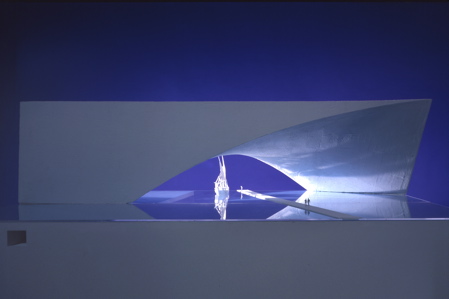
Architects Frank Gehry, Jean Nouvel, Tadao Ando (above) and Zaha Hadid have designed cultural buildings for Saadiyat Island, which lies just off the shore of Abu Dhabi in the United Arab Emirates.
With four leading international architects designing buildings, the project will create one of the world’s most prestigious cultural centres – and the first in the Arab world.
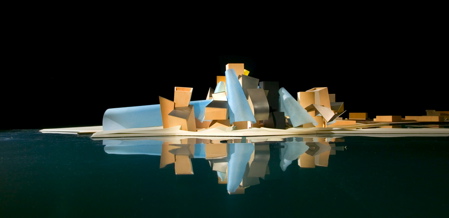
Gehry is designing a Guggenheim contemporary art museum (above), which will be the first of its kind in the Middle East.
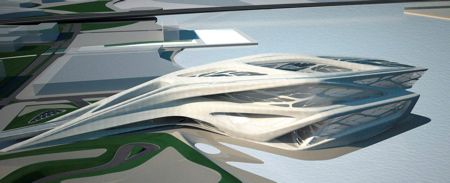
Hadid is designing Saadiyat’s Performing Arts Centre (above), and Nouvel is designing a Classical Arts Museum (below).
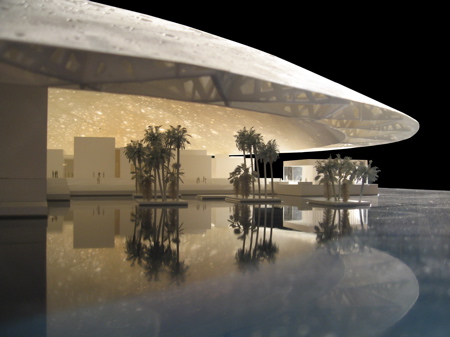
Ando is designing a Maritime Museum, which is shown at the top of the page and below.
The four buildings have been commissioned by Abu Dhabi’s Tourism Development & Investment Company.
“The aim of Saadiyat Island must be to create a cultural asset for the world; a gateway and beacon for cultural experience and exchange,” said Sheikh Mohammed bin Zayed, the crown prince of the United Arab Emirates and chair of the development’s executive council. “Culture crosses all boundaries and therefore Saadiyat will belong to the people of the UAE, the greater Middle East and the world at large.”
The Sheikh also announced an international architecture competition for the Sheikh Zayed National Museum on Saadiyat Island, which will be devoted to the history and traditions of Abu Dhabi.
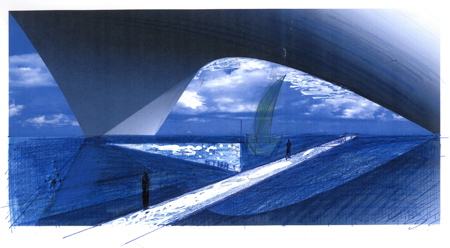
Abu Dhabi’s Tourism Development & Investment Company provided the following information on Ando’s Maritime Museum (above) and on the project in general:
Ando’s Maritime Museum concept takes its inspiration from Abu Dhabi’s natural surroundings, landscape and maritime traditions. It has a reflective surface visually merging sea and land. Its ship-like interior has floating decks which guide visitors through the exhibition space.
“Dhows float over the voids of the interior space and help create an intense visual experience by relating objects to one another and to the museum architecture as a whole,” explained Ando. “Below ground, there is a second space – a reception hall with an enormous aquarium. A traditional dhow floats over the aquarium and is seen from different perspectives.
“In order to emphasise the simple, but powerful, shape of the building, the surrounding landscape is organised in grid form. Rows of trees line the forecourt of the site, creating an oasis-like border that allows visitors to transition gradually between the dynamic city and the more serene and contemplative space of the museum.”
One of the world’s most experienced museum consultants, Lord Cultural Resources, has been appointed to plan content and operational matters for the Sheikh Zayed National Museum and the Maritime Museum.
The USA-headquartered award-winning architecture, urban design, engineering and interiors firm Skidmore, Owings & Merrill LLP (SOM) has created the final master plan for the Cultural District.
Saadiyat Island’s Cultural District – one of six distinct districts master planned for the signature destination – will also feature a Biennale Park and 19 international pavilions which will be criss-crossed by a 1.5 kilometre long navigable canal. The 19 pavilions, which will host a range of art and cultural events and activities, will be designed by some of today’s leading architects. These include UAE’s Khalid Alnajjar Russia’s Yuri Avvakumov, the USA’s Greg Lynn whom Forbes Magazine named one of the ten most influential living architects, New York’s Hani Rashid, the UK’s David Adjaye, China’s Pei-Zhu and Korea’s Seung H-Sang.
“It is also our long-term ambition to develop a creative campus of graduate schools in the fine arts within Saadiyat Island’s Cultural District,” said Sheikh Sultan. “These will be devoted to art, architecture, music and drama. Special attention will also be given to developing educational outreach programmes for the youth of the entire Gulf region.”
Sheikh Sultan added that the Saadiyat Cultural District will act as a “bridge crossing a cultural divide” providing a captivating mix of Arab and Western cultures.
“The contemporary programmes in the Saadiyat Island Cultural District in both the visual and performing arts must be grounded in the cultural traditions of the Middle East as well as the world at large,” he said.
The museums on Saadiyat Island’s Cultural District are scheduled to open under a phased programme starting in 2012. “The development of Saadiyat Island will progress at a considered pace which acknowledges our national environment, heritage and culture,” added Sheikh Sultan.
–
Update: here is a full press release about the Saadiyat Island cultural project:
ABU DHABI COMMISSIONS WORLD’S TOP ARCHITECTS FOR MUSEUM AND PERFORMING ARTS CENTRE DESIGNS
SAADIYAT ISLAND TO BECOME GLOBAL CULTURAL HUB
GEHRY, HADID, NOUVEL AND ANDO CONCEPTS GO ON PUBLIC DISPLAY
United Arab Emirates, Abu Dhabi, 31st January 2007:
Four of the world’s most renowned architects – Frank Gehry, Jean Nouvel, Tadao Ando and Zaha Hadid– have presented designs commissioned by Abu Dhabi’s Tourism Development & Investment Company (TDIC) for iconic museums and a performing arts centre which will position the UAE capital’s Saadiyat Island, that lies just offshore the emirate, as a world-class cultural destination.
A special exhibition devoted to the concept designs of the projects, complete with building models, was opened today at the prestigious, Emirates Palace Hotel in Abu Dhabi by His Highness Sheikh Mohammed Bin Zayed Al Nahyan, Crown Prince of Abu Dhabi and Executive Council Chairman.
“Saadiyat Island demonstrates the vision of His Highness Sheikh Khalifa Bin Zayed Al Nahyan, President of the United Arab Emirates and Ruler of Abu Dhabi,, to further establish Abu Dhabi’s position as a destination of international standing,” said His Highness Sheikh Mohammed bin Zayed.
“The aim of Saadiyat Island must be to create a cultural asset for the world. A gateway and beacon for cultural experience and exchange. Culture crosses all boundaries and therefore Saadiyat will belong to the people of the UAE, the greater Middle East and the world at large.” He added.
In addition to the museums and a performing arts centre for which concept designs have been presented, Saadiyat Island’s Cultural District will also feature the Sheikh Zayed National Museum – a museum devoted to the history and traditions of Abu Dhabi and the legacy of the emirate’s much-admired late ruler His Highness Sheikh Zayed Bin Sultan Al Nahyan, who was also the first President of the United Arab Emirates and often referred to as ‘The Father Of The Nation.’
“It is our intention to shortly embark on an international competition for the design of the Sheikh Zayed National Museum which reflects the importance and centrality we place on this facility,” explained His Highness Sheikh Sultan Bin Tahnoon Al Nahyan, Chairman of Abu Dhabi Tourism Authority (ADTA) and TDIC.
“This museum will pay tribute to our grandfathers and ancestors who left a wealth of cultural heritage that we are proud of. Within the Sheikh Zayed National Museum we shall conserve this heritage and build on it, as it is the soul of this land and its future generations.”
All four architects are international award-winners with three being holders of the coveted Pritzker Prize – the highest honour within the architectural discipline.
Frank Gehry is designing the Guggenheim Abu Dhabi – a contemporary art museum, which will be the only one of its kind in the Middle East; the British/Iraqi born architect Zaha Hadid is designing Saadiyat’s Performing Arts Centre, which will present the finest in music, theatre and dance, Jean Nouvel of France is designing the Classical Museum, while Japan’s Tadao Ando is designing the Maritime Museum which will reflect the rich maritime history of the UAE and the Arabian Gulf.
The Gehry concept for the Guggenheim Abu Dhabi Museum, which at 320,000 square feet will be the world’s largest Guggenheim museum, is designed around accommodating approximately 130,000 square feet of exhibition space. It will feature
permanent collections, galleries for special exhibitions, a centre for art and technology, a children’s art education facility, archives, library and research centre and a state-of-the-art conservation laboratory.
“Approaching the design of the museum for Abu Dhabi made it possible to consider options for design of a building that would not be possible in the United States or in Europe,” said Gehry. “It was clear from the beginning that this had to be a new invention. The landscape, the opportunity, the requirement, to build something that people all over the world would come to and the possible resource to accomplish it opened tracks that were not likely to be considered anywhere else. The site itself,
virtually on the water or close to the water on all sides, in a desert landscape with the beautiful sea and the light quality of the place suggested some of the direction.”
In the Gehry design, four storeys of central core galleries are laid out around a courtyard. “These will be more classical contemporary galleries, completely air conditioned with skylights where possible and a sophisticated lighting system,” said Gehry. Two more rings of galleries span out from the core.
“The third ring is for larger galleries, built more like raw industrial space with exposed lighting and systems. They would be less finished. These galleries will be attractive as spawning homes for a new scale of contemporary art – art that would be, perhaps, made on site and of a scale that could not be achieved in the normally organised museums around the world.”
In Hadid’s Performing Arts Centre concept, a 62 metre high building is proposed housing five theatres – a music hall, concert hall, opera house, drama theatre and a flexible theatre with a combined seating capacity for 6,300 – that’s 1,100 more than London’s Royal Albert Hall. The Centre may also house an Academy of Performing Arts.
“As it winds through the site, the architecture increases in complexity, building up height and depth and achieving multiple summits in the bodies housing the performance spaces, which spring from the structure like fruits on a vine and face westward, toward the water,” explained Hadid.
“The building becomes part of an inclining ensemble of structures that stretch from the Maritime Museum at its southern end to the Guggenheim Abu Dhabi at the northern tip. With its centre of mass at the water’s edge, the Performing Arts Centre focuses its volume along the central axis of the site. This arrangement interrupts the block matrix at the Arterial Road, opening views to the sea and the skyline of Abu Dhabi.
“The concert hall is above the lower four theatres, allowing daylight into its interior and dramatic views of the sea and city skyline from the huge window behind the stage. Local lobbies for each theatre are orientated towards the sea to give each visitor a constant visual contact with their surroundings.”
Nouvel’s design concept for the Classical Museum owes much to Saadiyat’s natural surroundings.
“The island offers a harsh landscape, tempered by its meeting with the channel, a striking image of the aridity of the earth versus the fluidity of the waters,” said Nouvel. “These fired the imagination towards unknown cities buried deep into the sands or sunk under water. These dreamy thoughts have merged into a simple plan of an archaeological field revived as a small city, a cluster of nearly one-row buildings along a leisurely promenade.
“This micro-city requires a micro-climate that would give the visitor a feeling of entering a different world. The building is covered with a large dome, a form common to all civilisations. This one is made of a web of different patterns interlaced into a translucent ceiling which lets a diffuse, magical light come through in the best
tradition of great Arabian architecture. Water is given a crucial role, both in reflecting every part of the building and acting as a psyche, and in creating, with a little help from the wind, a comfortable micro-climate.”
Ando’s Maritime Museum concept takes its inspiration from Abu Dhabi’s natural surroundings, landscape and maritime traditions. It has a reflective surface visually merging sea and land. Its ship-like interior has floating decks which guide visitors through the exhibition space.
“Dhows float over the voids of the interior space and help create an intense visual experience by relating objects to one another and to the museum architecture as a whole,” explained Ando. “Below ground, there is a second space – a reception hall with an enormous aquarium. A traditional dhow floats over the aquarium and is seen from different perspectives.
“In order to emphasise the simple, but powerful, shape of the building, the surrounding landscape is organised in grid form. Rows of trees line the forecourt of the site, creating an oasis-like border that allows visitors to transition gradually between the dynamic city and the more serene and contemplative space of the museum.”
One of the world’s most experienced museum consultants, Lord Cultural Resources, has been appointed to plan content and operational matters for the Sheikh Zayed National Museum and the Maritime Museum.
The USA-headquartered award-winning architecture, urban design, engineering and interiors firm Skidmore, Owings & Merrill LLP (SOM) has created the final master plan for the Cultural District.
Saadiyat Island’s Cultural District – one of six distinct districts master planned for the signature destination – will also feature a Biennale Park and 19 international pavilions which will be criss-crossed by a 1.5 kilometre long navigable canal. The 19 pavilions, which will host a range of art and cultural events and activities, will be designed by some of today’s leading architects. These include UAE’s Khalid Alnajjar Russia’s Yuri Avvakumov, the USA’s Greg Lynn whom Forbes Magazine named one of the ten most influential living architects, New York’s Hani Rashid, the UK’s David Adjaye, China’s Pei-Zhu and Korea’s Seung H-Sang.
“It is also our long-term ambition to develop a creative campus of graduate schools in the fine arts within Saadiyat Island’s Cultural District,” said Sheikh Sultan. “These will be devoted to art, architecture, music and drama. Special attention will also be given to developing educational outreach programmes for the youth of the entire Gulf region.”
Sheikh Sultan added that the Saadiyat Cultural District will act as a “bridge crossing a cultural divide” providing a captivating mix of Arab and Western cultures.
“The contemporary programmes in the Saadiyat Island Cultural District in both the visual and performing arts must be grounded in the cultural traditions of the Middle East as well as the world at large,” he said.
The museums on Saadiyat Island’s Cultural District are scheduled to open under a phased programme starting in 2012. “The development of Saadiyat Island will progress at a considered pace which acknowledges our national environment, heritage and culture,” added Sheikh Sultan.
The Saadiyat Island Cultural District exhibition will be at the Emirates Palace Hotel in Abu Dhabi. The exhibition, which is free-of-charge, is open from 10am until 10pm daily with the exception of Mondays when it will be closed.
Notes To Editors:
About Saadiyat Island’s Cultural District:
In 2004, the Abu Dhabi Tourism Authority (ADTA) embarked on a vision of developing Saadiyat Island into a world-class, environmentally sensitive tourist destination that included as its centerpiece the creation of a new cultural district for Abu Dhabi and the United Arab Emirates. This vision was translated into a Masterplan through the appointment of the USA’s Gensler Associates and under UAE Law No:12, the establishment of a wholly-owned public joint stock company, the Tourism Development Investment Company (TDIC).
Included within the massive project was an impressive array of features and amenities, including commercial and residential properties, resort hotels, recreational facilities, nature preserves, and perhaps most significantly, the idea to create a cluster of world class cultural facilities and institutions that would be operated in partnership with established museums and performing arts institutions from around the world. Abu Dhabi had embarked on one of the most ambitious urban and cultural development projects ever conceived.
The guiding principles for the Cultural District are to make it, by definition, a destination everyone in the worlds of art and culture would want to visit, annually and more than once. This will be achieved by building a series of permanent institutions – museums, performing arts centres, exhibition halls, educational institutions in the arts – that through its collections, architecture and programmes will become one of the greatest concentrations of cultural experiences anywhere in the world.
About Saadiyat Island:
Saadiyat Island – which translates from Arabic as Island of Happiness – is the largest single mixed-use development in the Arabian Gulf. The 27 square kilometre natural island – half the size of Bermuda – lies only 500 metres offshore Abu Dhabi island – the capital city of the United Arab Emirates. Saadiyat Island is being developed into a complete visitor and residential destination.
Saadiyat Island represents one of the most important development opportunities in Abu Dhabi’s history. The island, which has 30kms of water frontage and boasts many natural eco-features including mangrove forests, is being developed as a strategic international tourism destination and marks a new era in the rapid evolution of Abu Dhabi, the largest of the seven emirates which form the UAE Federation.
Saadiyat Island will be developed in three phases with total completion scheduled for 2018. The masterplan envisages six highly individual districts and includes 29 hotels, including an iconic 7-star property, three marinas with combined berths for around 1,000 boats, museums and cultural centres, two golf courses, civic and leisure facilities, sea-view apartments and elite villas.
Saadiyat Island is expected to be home to a community of more than 150,000 people – the same population size as Chang Mai in Thailand, Oxford in the UK or Hollywood in the USA.
Saadiyat Island will be linked to the main Abu Dhabi island and the Abu Dhabi mainland via two, 10-lane freeways making the destination easily accessible to Abu Dhabi International Airport, which will be just a 25 kilometre drive away.
Saadiyat Island is being developed by the Tourism Development & Investment Company (TDIC), an independent public joint stock company of which Abu Dhabi Tourism Authority is the sole shareholder. TDIC’s strategy is to dispose of development land on the island to private investors who will each develop their sites in accordance with the masterplan and supporting planning regulations and design guidelines.
About Tourism Development & Investment Company:
Tourism Development & Investment Company (TDIC) is a public joint stock company established under Law No: 12 of 2005 as decreed by the Abu Dhabi Ruler and UAE President, His Highness Sheikh Khalifa Bin Zayed Al Nahyan. TDIC is an independent organisation empowered to manage the tourism investment zones of the Abu Dhabi Tourism Authority (ADTA), which directs and implements strategy for the expansion of the emirate’s tourism sector. TDIC will develop the real estate assets that support ADTA’s mission of assisting UAE economic diversification through tourism development.
TDIC, launched with an initial paid-up capital of AED100 million (US $27.5 million) with its shareholding fully owned by ADTA, operates along strictly commercial lines with its projects being self-sustaining and economically feasible. Its activities include creating development and tourism related concepts for specific sites and locations, disposing of, or repositioning, government-owned tourism related assets, entering into joint ventures with investment partners for assets such as hotels or residential products, as well as serving as the master developer for large scale projects.
About Abu Dhabi:
Spread over 87,340 square kilometres, Abu Dhabi is the largest of the seven emirates which make up the United Arab Emirates and accounts for more than 85% of the country’s total landmass. The UAE is one of the six members of the Arabian Gulf Co-operation Council.
Abu Dhabi city, built on the largest of almost 200 natural offshore islands in the emirate, is the capital both of the emirate and of the UAE. It is the federal seat of government and home to most ministries and institutions, embassies, state broadcasting facilities and oil companies.
Abu Dhabi’s population is currently around 1.6 million and is expected to grow by 6.8 per cent per annum over the next decade to a projected 3.4 million by 2015.
Abu Dhabi has an estimated 9.2% of the world’s proven oil reserves and 4% of its total proven natural gas reserves. The emirate has a per capita income of US $46,185 – the highest in the world. Realising the challenges posed by the country’s heavy economic reliance on finite carbon resources, the emirate’s leadership is actively pursuing economic diversification.




不错不错,就是鸡肠太多。来翻译一个~